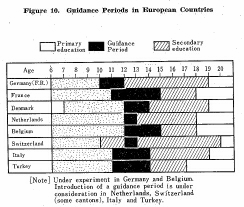| Home > Policy > White Paper, Notice, Announcement > White Paper > EDUCATIONAL STANDARDS IN JAPAN 1965 > CHAPTER |
||
Observation of aptitudes is a method of guidance which is intended to place each pupil in a program of study best suited to his personal aptitudes by means of observation continued for a specified period of the pupil's activity and performance in classes by classroom teachers and guidance specialists. The "Observation Cycle" established in the first stage of secondary education in France represents this type of method. In the "Observation Cycle" pupils are initially allocated to an appropriate course based on the school records from primary schools (Elementary Cycle, Cycle Elementaire). The curriculum of each course, however, remains common through the period excluding any vocational subjects. Observation of aptitude is practiced in the classes for "experimental studies of natural sciences" and "preparation of lessons" as well as in the ordinary classroom lessons. Observation in the former classes aims at helping to assess aptitudes difficult to determine in regular class activities, and that in the latter put emphasis on the improvement of the way of learning and scholarly attainment of each pupil.
The Guidance Council consists of the regular classroom teachers, school and vocational guidance councelors in each prefecture (Department), school doctors, community representatives with knowledge and experience and representatives of parents. The Council studies the reports of observations and the proposals made by the families on the future courses of their children. At the end of the first quarter of the 6th grade(the first year of the Observation Cycle) and at the end of each grade in the Observation Cycle, the Guidance Council gives the families its opinions of the type of courses which seem best suited to the pupils' aptitudes, providing either for transfer of pupils to more suitable courses or report final decision of the course most suitable to their aptitudes and abilities.
Families and pupils remain free to follow the Guidance Council's opinion or not. In case they choose some other course than proposed by the Council, pupils have to pass an entrance examination.
Special classes called "transfer" classes are established at the level of the 8th and 9th grades beyond the Observation Cycle of the 6th and 7th grades, and accept pupils who are transferred to more suitable courses as a result of further information of pupils' aptitudes and require them to makeup work to catch up to the regular classes. In connection with the prolongation of the observation circle, a comprehensive type of school has been recently established aiming at the practice of more effective transfer from one type of course to another during the first stage of secondary education(that is the Observation Cycle).

At present, only Denmark provides an observation period similar to that in France. The Federal Republic of Germany and Belgium have instituted observation periods on an experimental basis. Italy, the Netherlands, a part of the cantons in Switzerland, and Turkey have been contemplating the introduction of an observation period of the same type. Figure 10 shows the stages of the observation periods which varies from country to country.
| Back to Top | MEXT HOME |